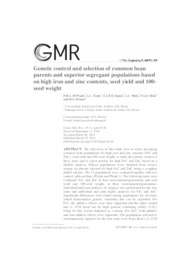Genetic control and selection of common bean parents and superior segregant populations based on high iron and zinc contents, seed yield and 100- seed weight.
Genetic control and selection of common bean parents and superior segregant populations based on high iron and zinc contents, seed yield and 100- seed weight.
Author(s): DI PRADO, P. R. C.; FARIA, L. C.; SOUZA, T. L. P. O.; MELO, L. C.; MELO, P. G. S.; PEREIRA, H. S.
Summary: The objectives of this study were to select promising common bean populations for high iron and zinc contents (FeC and ZnC), seed yield and 100-seed weight, to study the genetic control of these traits and to select parents for high FeC and ZnC based on a diallele analysis. Fifteen populations were obtained from crosses among six parents selected for high FeC and ZnC using a complete diallel scheme. The 15 populations were evaluated together with two control cultivars/lines (Pérola and Piratã 1). The following traits were evaluated: FeC and ZnC in four environments/generations and seed yield and 100-seed weight, in three environments/generations. Individual and joint analyzes of variance were performed for the four traits and individual and joint diallel analyzes for FeC and ZnC. Significant differences were found among populations for all traits, which demonstrates genetic variability that can be exploited. For FeC, the additive effects were more important and the white seeded line G 2358 stood out for high general combining ability (5.63), being for this reason indicated as a parent. For ZnC, both additive and non-additive effects were important. The populations selected as simultaneously superior for the four traits were Porto Real x G 2358 and BRSMG Majestoso x G 2358, with at least one parent with carioca seeds; and BRS Requinte x BRSMG Majestoso, Porto Real x BRS Requinte and Porto Real x BRSMG Majestoso, with carioca seeds. The BRS Requinte x G 2358 population is recommended to obtain lines with high FeC and ZnC.
Publication year: 2019
Types of publication: Journal article
Unit: Embrapa Rice & Beans
Observation
Some of Embrapa's publications are published as ePub files. To read them, use or download one of the following free software options to your computer or mobile device. Android: Google Play Books; IOS: iBooks; Windows and Linux: Calibre.
Access other publications
Access the Agricultural Research Database (BDPA) to consult Embrapa's full library collection and records.
Visit Embrapa Bookstore to purchase books and other publications sold by Embrapa.

